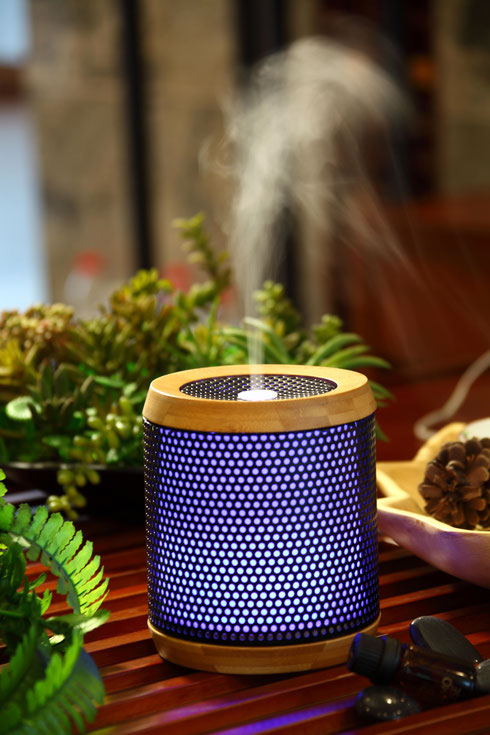Ultrasonic diffusers are very popular in various domains, so it is likely that you have seen one of them before (even if you did not know what it was at the time). Diffusers create a humidifying mist in the air, and they come in so many shapes, sizes, and materials, that you can easily find a perfect fit for your home and your personal style.
In addition, the way they make the “cold steam” is actually really cool...

Ultrasonic diffusers: How do they work and how do you use them?
The essential
An ultrasonic diffuser is a device used to spread essential oil(s) in a room with the help of water.
A mist (also called ‘cold steam’) carries aromatic components into the air of a medium to a large room.
The mist itself is created by a mechanical system that causes a magnet to vibrate at a high frequency under a bowl of water into which some drops of aromatic oils have been added.
Structure of the article
1. How does an ultrasonic diffuser work?
1.1 Under the hood of an ultrasonic diffuser
1.2 An ultrasonic diffuser in action (video).
1.3 The physics behind the ultrasonic system
1.4 Maintenance of a mist diffuser
2. Ultrasonic diffusers for which kind of home?
2.1 How large should the room be?
2.2 How long should an ultrasonic device diffuse?
2.3 How many drops should I add?
2.4 What do I do if I add too many drops?
2.5 Where should I put an ultrasonic diffuser?
3.Conclusion
- Giveaway: How to measure the humidity of a room?
- Disclaimer
- Pictures
1. How does an ultrasonic diffuser work?
1.1 Under the hood of an ultrasonic diffuser
This kind of device is generally composed of a bowl and a cover. Under the bowl (which contains the water) lies a ceramic disc. When activated, this disc moves back and forth very quickly which creates ultrasonic vibrations.
These vibrations are strong enough to transform liquid water into very small drops of mist. A fan helps lift this cold steam into the air. The essential oil present in the water is diffused by the droplets of mist.
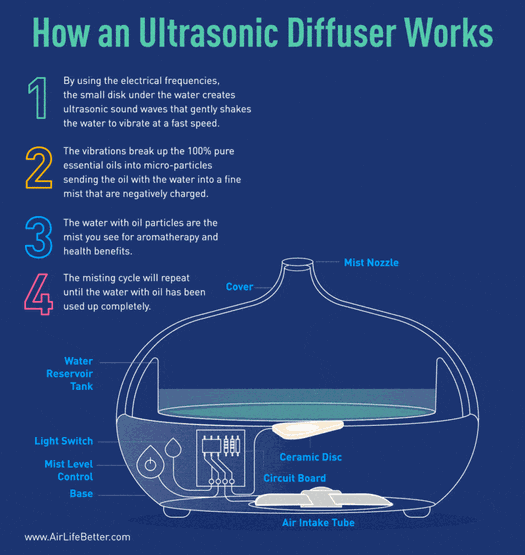
Animation Airlifebetter.com
Tip
These diffusers are generally very quiet when in use. If you do hear noise, it is generally not the sound of the vibrations themselves, but rather the bubbles created by those vibrations.
1.2 An ultrasonic diffuser in action (video).
Video ultrasonic diffuser Audelia by Innobiz
1.3 The physics behind the ultrasonic system
A few days ago, I was watching the Slow Mo Guys’ YouTube channel with my son. We found an interesting video about a laboratory device called a vibrating stick (no really--I am not joking).
The device is used in laboratories to mix substances that cannot normally be blended, like oil and water. To get this result, it makes use of the same system employed by cold steam diffusers.
It is mesmerizing to watch a drop of water on a 3 mm stick vaporize due to frequency. Here is the video:
Youtube video from Slow Mo Guys about ultrasonic effects
1.4 Maintenance of a mist diffuser
The main concern for maintaining a mist aroma diffuser is to be careful of your water quality. Although the water quality here in Copenhagen is good, the water is very hard.
The high content causes limescale, which is a common problem for kettles, washing machines, and even the skin.
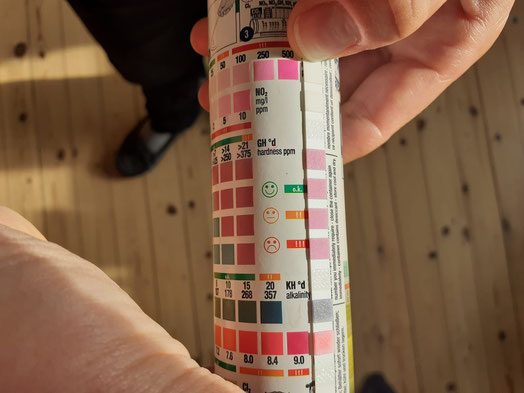
Hardness test of water from the tap in our flat (Danmark)
What this means is that limescale can very quickly coat the bowl of your ultrasonic diffuser.
However, there are some very simple solutions for this problem similar to those of other appliances. You can simply remove the fine layer of calcium scale after each use of the diffuser. Occasionally, it may be a good idea to apply a soak in white vinegar in much the same manner as one would if descaling a kettle or coffee machine. After the desired effect has been reached, rinse the bowl carefully to remove the vinegar smell.
In case your diffuser seems to carry a very heavy reminiscent aroma of previous diffusions, you have several options. For example:
- Pour one teaspoon of baking soda and then half of a teaspoon of white vinegar in the bowl of the diffuser.
- Spread the mixture with care (use gloves or a kitchen towel) and let it bubbles max. for 5 minutes.
- Rinse with warm water. I have had some success with this method for cleaning and sanitizing secondhand diffusers. However, sometimes, even this method may not be enough.
Tip
If you decide to buy a secondhand diffuser, always be sure the smell of the previous oils used is not too strong. I once purchased a secondhand diffuser on which the scent of a poor quality Patchouli and the Geranium oils blend was so strong that I could not get rid of it entirely.
2, Ultrasonic diffusers for which kind of home?
2.1 How large should the room be?
As mentioned above, cold steam or ultrasonic diffusers come in an array of different shapes and sizes. One of the current trends is for them to come with an array of multi-colored lights which change color constantly.
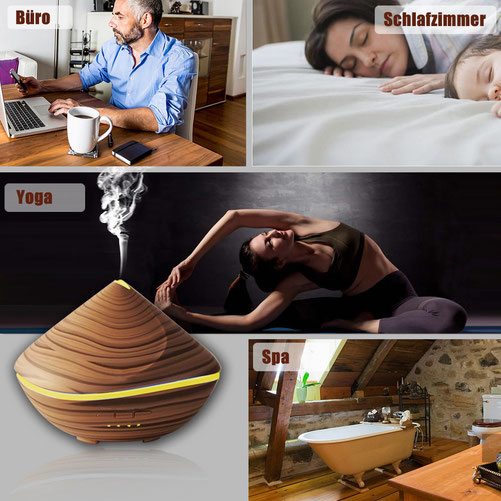
Commercial picture
In terms of technicalities, it is generally possible to adjust the frequency of diffusion and (sometimes) its intensity as well.
Ultrasonic diffusers are generally used in large rooms, e.g.
- Living rooms,
- Open-plan kitchens,
- Large bedrooms
Using this ultrasonic diffuser with essential oils in a living room has the advantage of creating an olfactive atmosphere for the room, and also humidity in the air at the same time.
2.2 How long should an ultrasonic device diffuse?
The short answer is that it depends on the room.
In the case of a large living room, an ultrasonic diffuser can “smoke” for hours during a reception or for a relaxing moment while reading or watching TV.
As long as the smell of the essential oils being diffused is within the use recommendations of the oils and does not otherwise bother the persons in the room, it should not be problematic.
As a general rule of thumb, the maximum diffusion duration for an ultrasonic device is also dependent upon the volume of the machine’s bowl. According to my research, a good general guideline is
- Two hours of diffusion per 100 ml of water. In this way, a diffuser with a 300 ml bowl can diffuse for around six hours.
- Even if these devices are more or less silent, you should avoid diffusing aromatic oils while asleep. An excess of the aromatic components in the air can provoke headaches, for example.
- This does not mean that diffusers cannot be used in the bedroom, however. As always, it is best to follow safe practices and product recommendations.
- If you want to use oils to promote sleep, diffuse before going to bed, and switch off the diffuser during the night.
It is important to also mention that recommendations suggest avoiding diffusing for longer than an hour, especially in the presence of babies or young children.
They cannot always express their discomfort and they can be more sensitive to an aroma than we are.
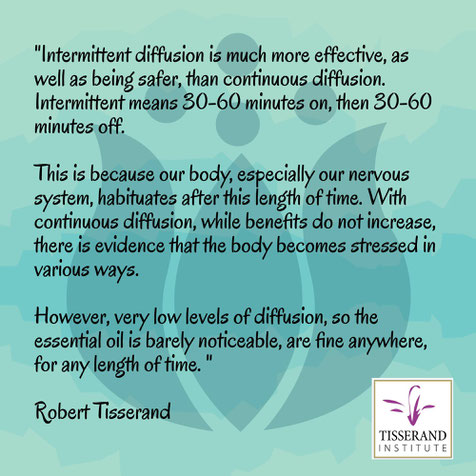
2.3 How many drops should I add?
Aromatherapists suggest 3 drops per 100 ml of water volume. So, for an ultrasonic diffuser with a 200ml capacity, you can start with 6 drops. Just as a reminder, 1 ml of essential oil contains c. 30 drops [To learn more about the number of drops per ml]
All in all, these figures are pretty economical. With 200 ml of water and 6 drops of essential oil(s), you can diffuse for a total of two hours.
Of course, the number of drops depends on the “strength” of the oil or blend and your sensitivity.
This proportion (3 drops for 100 ml) may seem low at first. However, remember that it is always easier to add more drops than it is to take them out again. Recommendations suggest not exceeding 6 drops per 100 ml.
2.4 What do I do if I add too many drops?
Over-diffusion of essential oils can cause headaches, respiratory irritation, dizziness, and/or irritation of the eyes. If this happens to you, the best practice is:
- The first thing to do is air the room thoroughly. Open the windows, let in the breeze, and get a change of air.
- Remember that the diffusion intensity of some devices can be adjusted. If this is the case for you, don’t hesitate to dial your diffusion down, or even choose an alternative diffusion method.
- If you add too many drops to the bowl, add more water to increase the dilution, thereby decreasing the percentage of oil diffused.
- IIf you have a full bowl and too many drops, just take out half of the water into a clean har, and add more water to the half remaining to increase dilution(see above). If you keep the jar closed, you can still use it for the next diffusion round, after ensuring proper dilution, of course.
2.5 Where should I put an ultrasonic diffuser?
The best place to set an ultrasonic diffuser is in a high place. The reason for placing an ultrasonic diffuser in an elevated location is due to the fan.
If you recall, the mist coming out of the diffuser is propelled by a fan. Because the aromatic droplets in the mist are heavier than air, they will gradually fall to the ground.
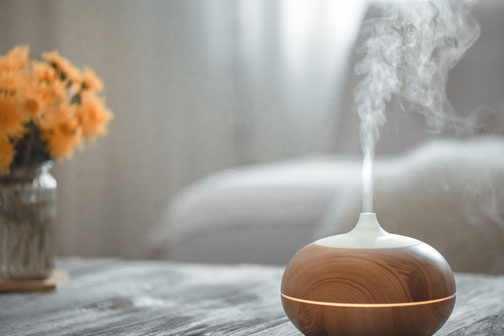
Water photo created by pvproductions - www.freepik.com
Setting the aromatic diffuser in a high place allows for a better repartition of the aromatic components throughout the room. This is especially the case when there is little or no movement in the room.
When you walk by a diffuser in operation, the movement of the air helps the aromatic droplets to spread around the room.
Tip
It is important to correctly set the intensity of the diffuser (if possible) to avoid dampening the piece of furniture on which the diffuser is placed. It can happen that the fan may not be powerful enough with some settings to elevate the droplets so that the mist condenses on the table or shelf on which the device is sitting.

Water under the diffuser due to a wrong setting
As a good rule of thumb
Place a diffuser as high as possible in an open place as possible in order to help it diffuse effectively.
3. Conclusion
Ultrasonic diffusers are very common nowadays. They are not very expensive and they are available in many sizes and shapes, making it easy to find an example that fits your lifestyle.
But there are also several parameters which one should take into consideration before purchasing this kind of diffuser,
- Size of the room
- Duration of diffusion
- Placement of the diffuser
- Humidity in the room
While we did not delve deeply into this last point, it remains nonetheless a very important consideration for the well-being of living space.
In Sweden, researchers studied the percentage of humidity in the air. By their estimations, the optimum relative humidity percentage in a room should be between 40 and 60%.
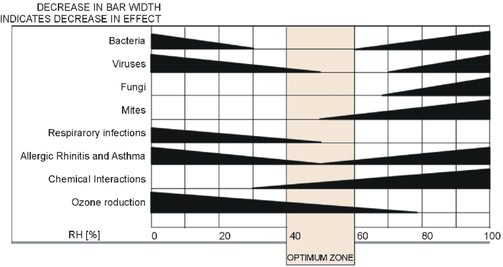
If a room is either too dry or too humid, it favors the development of bacteria and mold, which may lead to unfavorable allergies…
Ultrasonic diffusers can help to create a better atmosphere or quality of air in the house, however, they need to be used correctly in respect to the recommendations, or else they have the opposite effect.
Giveaway: How to measure the humidity of a room?
A very simple test will help you to get an idea about the humidity of your home without investing in a hygrometer (an instrument for measuring humidity).
All you need is a big glass of water and some ice cubes.
- Bring the glass with the ice into the room to be tested and let it sit for c. 10 minutes.
- If there is condensation outside the glass, the air in the room has a relatively high humidity level.
- If the exterior of the glass is dry, the air in this room is dry.
This quick test will tell you if the room is dry or humid. For greater precision, one needs two thermometers, but that is another story :)
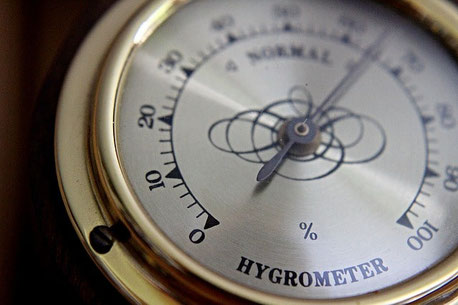
Classic hygrometer
Alternatively, the hydrometers mentioned above can be an effective option for testing humidity. Even very simple ones are often quite effective.
Be safe, be essential!
You can be part of the Very Essential People group.
You will get informed of the new articles and you will get discounts on the Après-You e-shop, you just have to sign up.
It is free and without engagement.
Disclaimer
I do not pretend or want to replace any medical judgment or prescription. All the information within this post is intended to be informative! Please, always use essential oils carefully and with respect. In case of doubt, always ask a medical professional first.
Pictures
If you have any questions or remarks about the pictures and credits, feel free to send an email to info@apres-you.com.



